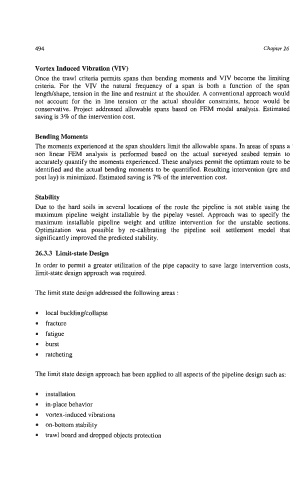Page 527 - Pipelines and Risers
P. 527
494 Chapter 26
Vortex Induced Vibration (VIV)
Once the trawl criteria permits spans then bending moments and VIV become the limiting
criteria. For the VIV the natural frequency of a span is both a function of the span
lengthlshape, tension in the line and restraint at the shoulder. A conventional approach would
not account for the in line tension or the actual shoulder constraints, hence would be
conservative. Project addressed allowable spans based on €EM modal analysis. Estimated
saving is 3% of the intervention cost.
Bending Moments
The moments experienced at the span shoulders limit the allowable spans. In areas of spans a
non linear FEM analysis is performed based on the actual surveyed seabed terrain to
accurately quantify the moments experienced. These analyses permit the optimum route to be
identified and the actual bending moments to be quantified. Resulting intervention (pre and
post lay) is minimized. Estimated saving is 7% of the intervention cost.
Stability
Due to the hard soils in several locations of the route the pipeline is not stable using the
maximum pipeline weight installable by the pipelay vessel. Approach was to specify the
maximum installable pipeline weight and utilize intervention for the unstable sections.
Optimization was possible by re-calibrating the pipeline soil settlement model that
significantly improved the predicted stability.
26.3.3 Limit-state Design
In order to permit a greater utilization of the pipe capacity to save large intervention costs,
limit-state design approach was required.
The limit state design addressed the following areas :
local bucklinglcollapse
fracture
fatigue
burst
ratcheting
The limit state design approach has been applied to all aspects of the pipeline design such as:
installation
in-place behavior
vortex-induced vibrations
on-bottom stability
trawl board and dropped objects protection

